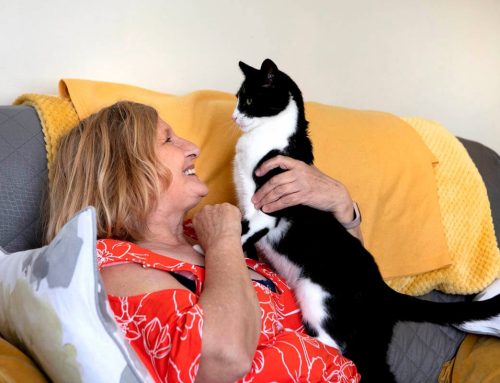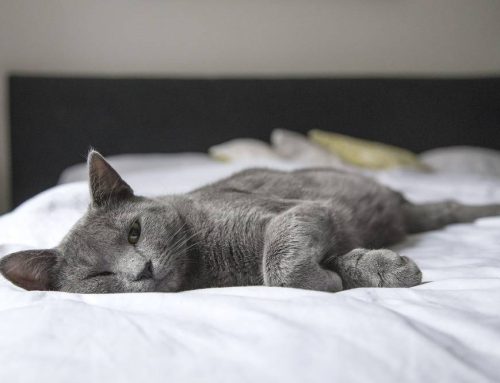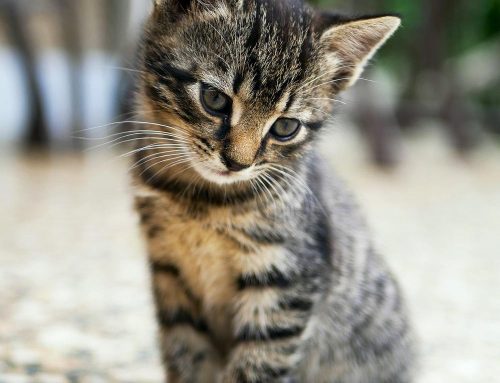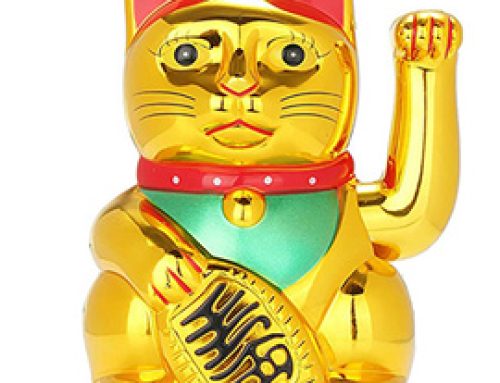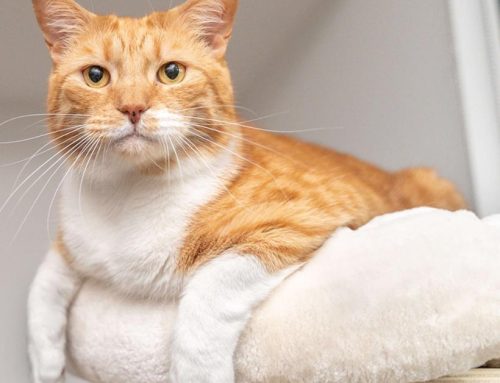Cats have been confusing veterinary clinicians with their bladder issues since at least the 1860’s. The mere fact that no one can agree on a title for the feline syndrome of increased frequency of urination – often away from the normal place (the litter tray) – with visible or congealed blood, that resolves within a few days, and upon which no medications seem to have an influence, would indicate multi-modal cause. Dr Kim calls it a Kitty Migraine.
What Causes FLUTD?
Cats given a stable, enriched environment have almost no episodes of FLUTD / FIC (Feline Lower Urinary Tract Disease (or Disorder) / Feline Interstitial Cystitis), even if they have previously had urethral blockages and repeated events of cystitis in other environments (home / client-based). These same cats were fed only dried food of a non-prescription type in the research facility. No viral, bacterial or other infectious component has ever been found to be involved. At the Palace, Dr Kim has a very behahaviour-oriented as well as primary care practice. She has found that 0.35% of the cats have presented with what she calls a ‘stress cystitis’, and it seems to represent an internalizing of their fears and anxieties.
Is It Serious?
The ‘blocked male cat’ is a critical emergency It is one of the most painful conditions a cat can endure and requires immediate veterinary attention. So if you see your male cat in the following posture, and particularly if he has not eaten and is licking his genital area, please seek attention before his bladder ruptures.
The Need for Understanding
Behavioural intervention is not boring or confusing and behavioural change is usually the first clue that all is not well with your feline friend. Limping, not eating, fussier, quieter, becoming clingier or more distant, not using the litter tray… all these are behavioural signs, and your cat is using them to indicate what, or where, their problem is.
To understand cats, you have to go back to their ethological origins. Single, mouse-eating desert carnivores who lie between prey and predator in the food chain strata. A creature whose stress response is ‘fight or flight’. These neurological responses to threat – real and, most importantly perceived – are key aspects of life for felines.
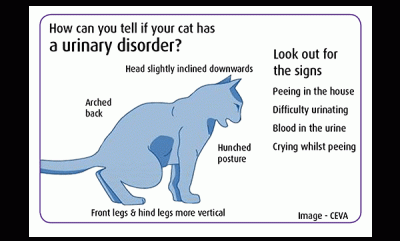
What makes a cat a cat?
We have changed cats’ environments substantially over the last 10,000 years since they domesticated us, and they have adapted by changing a great deal of their instinctive behaviour. Wild cats avoid humans, totally, and the true wild cats (Felis sylvestris sylvestris) cannot be tamed just by raising them in a human household. Our moggies have self-selected over the generations to tolerate, and now even seek out, human company. However, when something goes wrong for a cat, its ‘default emotion’ is fear. And if you fear something that might happen (ie a future event), that is the definition of anxiety.
Cats are smart enough to need anti-depressants (perhaps better to call it anti-anxiety medication) so it is not surprising to find that in this relatively feline-unfriendly world in which cats find themselves (no mice, no desert sand, too many cats and way too much noise) that many get stressed and anxious. And their behaviour changes.
Most cats will hide if they feel vulnerable: they do not ‘ask for help’ or make a noise that may alert a predator to their vulnerability. Sometimes illness or the source of stress will be clear: there is an obvious swelling or painful area or there is a change in urine, faeces or vomiting. However, cats usually indicate a problem by behaving differently.
Pee-mail
Felines are a very conservative species – they conserve water well (make very strong urine), conserve energy (that is why they sleep – they are not just being bone idle! And that is why it is so hard to get them to lose weight!). And they use their elimination products for a second purpose – communication. Many of you have experienced the fact that they use urine (and sometimes faeces) for messaging. You could even call it pee-mail!
Cats use pheromones and fatty acids in their urine to give other cats information, mainly about their time of arrival or departure, and sexual status. Cat urine actually DOES SMELL WORSE the longer it is outside of the cat – the amino acids breakdown to make the urine smellier at a constant rate, and the fatty acids make it very sticky so it stays around a long time. This then acts as a time marker and the message is usually ‘I was here at 4pm today and I don’t want to meet another cat here tomorrow’. This is very effective where there are few cats in a large area like a desert. However, in the crowded urban environment, it may prevent another cat from peeing at their appointed time and location.
Nearly all cat communication – auditory, pheromonal and all forms of marking (outside of mate-finding) – are designed as distance-increasing messages. They are not ‘stay away because I hate you’ messages (because urine sprayed is not aversive, it is investigated by other cats, in fact). So the message is just ‘don’t be here when I am, there are no mice anyway’ messages.
Evidence of stress
Cats are creatures of habit, and to disrupt that routine is very stressful. As a result, a cat’s bladder may go into spasm, sometimes badly enough to rupture small blood vessels. These then bleed into the urine making it red. For the cat, this is a bit like the ‘stress headaches’ we humans suffer when we get fraught and overwrought. The stress can also prevent the bladder from filling. The resultant damaged bladder lining is letting the urine irritate the deeper tissues. This means the cat is going to urinate more frequently and in different places. This is the cat desperately looking for somewhere that they find comfortable to relieve itself. After all, to a cat’s mind, urine itself cannot hurt. Therefore it must be the place they are peeing that is causing the hurt. Hence they look for another place to pee.
This is often the start of the difficult syndrome of a cat ‘peeing everywhere around the house’. If we pity the cat rather than punish them, we can help resolve their problem. This can relieve the pain quickly and with less mess for the owner. Try to remember – peeing SOLVES a cat’s problem: there is no moral issue or comment. Peeing IS the cat’s coping mechanism. To solve the owner’s problem, however, we are going to have to understand the problem from the cat’s point of view and make some changes to the environment.
How The Cat Responds
The underlying triggers for any of the behaviours that indicate the cat is resorting to coping measures (such as hiding, aggression or ‘peeing everywhere’) are as varied as the personalities of the cats and the environments their owners put them in. However, nearly all are based in some anxiety. If your cat is indicating stress by resorting to coping mechanisms frequently, then the two things to remember are: it is unlikely the cat will solve the problem alone so the problem will get worse; and the earlier the intervention the more likely the treatment will resolve the problem. Once the activity is a habit, it will take much longer and need much more medication and behavioural intervention to resolve.
Causes of stress
Cats have a wide range of responses both between and within individuals. In fact, every cat is representative but no cat is average. Variations can be genetic (even epigenetic – if the queen is stressed, her kittens will react more to a threat), environmental and contextual. Some cats go into overload if one piece of furniture is moved. Others are unfazed by the advent of babies, dogs, teenagers or even moving house. Moving house was actually the number one co-factor in cats who had FIC in one study.
The biggest threat to the emotional security of cats who suffer from FIC seems to be a change of routine. Whether as simple as just moving a chair, to a favourite person moving away, or moving house. And don’t underestimate the impact of introducing another cat. The one thing a cat cannot ignore is another cat. After all, the golden rule is that you only share your mouse with your offspring.
So if your cat starts peeing blood, find out whether a routine has changed. Often, it doesn’t take a significant change to throw a cat off balance emotionally. It could even be as simple as having a new cat staring in the window. It might even be that there is a changed relationship with a familiar cat in the household. Cats in any household have a very fluid status with other cats – it is time and space dependent. There is some work that shows that if there are ample resources (feeding stations, resting places – up high – water bowls and hiding places) then nearly all cats can reach a social compromise that does not involve peeing in ‘important’ places, but it will often take a year for an adult to integrate.
Introducing Other Cats
Very few cats want to live with more than one or two other cats, especially if this then restricts their choices. Remember a lot of cat communication is done by smell. Displaced aggression is where one cat gets aggravated by a cat outside, and turns on their housemate. This reaction is actually fairly common. In fact, it is so common that Dr Kim always insists owners bring both Burmese to the hospital. In addition any pairs of cats who hiss at each other after a vet visit both have to come along for the ride. This is to prevent the hissing (mild aggression) that follows if only one cat attends the vet then goes home smelling unfamiliar to the other cat.
Solving the issue
Pee-mail and other challenges will generally require a visit to Dr Kim. This is important to discuss the medical and behavioural issues that might be at play. There are truckloads of ‘tips’ on Dr Google, but if your cat is suffering, they will need a customized intervention. It is rarely going to be a simple diagnosis. Often, though the solution can be simple. It might be as easy as an alternative litter tray (or litter type) and pain relief.
Doctors and their patients who are struggling with Fibromyalgia and other chronic pain conditions have finally accepted a mental model:
‘This abnormality across conditions suggests that these individuals have a fundamental problem with pain or sensory processing rather than an abnormality confined to a specific region of the body where pain is perceived to originate. Similar types of therapies are efficacious for all of these conditions, including both pharmacological (e.g., tricyclic compounds such as amitriptyline) and nonpharmacological treatments (e.g., exercise or cognitive behavioural therapy). Conversely, individuals with these conditions typically do not respond to therapies that are effective when pain is due to damage or inflammation of peripheral tissues (e.g., NSAIDs, opioids, injections, or surgical procedures)”
The other issue for cats is that their locus coeruleus (in the brain) becomes depleted of the neurotransmitter nor-epinephrine. Quality sleep is when replenishment takes place, and stressed cats don’t sleep well. Dr Kim’s personal theory is that cats with FIC are not getting enough deep REM sleep. Hypervigilance is one of the factors observed prior to an episode of cystitis if the owners are questioned.
Should we just skip ahead though? For cats with FIC, should we consider that this condition really is where the mind matters to the medicine? It might avoid a lot of pain and suffering for our feline friends.
Some Key Points to Know
The treatment reality for feline cystitis is probably that no treatment works better than any other. Dr Kim works on the strategy of analyzing the problem with the view to preventing the next bout. This is especially cruciallly for the blocked boys. However, you should always be mindful of the pain involved. Using an NSAID, a benzodiazepine, a urinary acidifier and sometimes an opiate or maropitant in an acute treatment will help a part of the pain. In the long run, using amyltryptalline / nortryptalline / clomipramine – which take 2 weeks to work – may be the best plan, especially if the next episode comes within 6 months.
Some cats only ever have one incident of cystitis. As a result there is usually no reason for treatment to be a long term thing. Sometimes it is wise to change the food . Current research does not support wet food as a preventative. Although foods which make the urine more dilute in other ways have some benefit. It is extremely important to ALWAYS change the environment. Doing that effectively is where the art of vet science meets the investigative talents of forensic science and both use medical science to solve cats’ problems.
.


